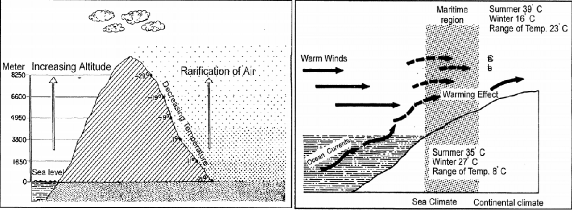3. Temperature
The temperature is the measurement in degrees of how hot (or cold) a thing (or a place) is. The temperature of the atmosphere is not same across the Earth. It varies in spatial and temporal dimensions. The temperature of a place depends largely on the insolation received by that
place. The interaction of insolation with the atmosphere and the earth’s surface creates heat which is measured in terms of temperature. It is important to know about the temperature distribution over the surface of the earth to understand the weather, climate, vegetation zones, animal and human life etc. following factors determine the temperature of air at any place.
1. The latitude of the place: Intensity of insolation depends on the latitude. The amount of insolation depends on the inclination of sun rays, which is further depends upon the latitude of the place. At the equator sun’s rays fall directly overhead throughout the year. Away from the equator towards poles, the inclination of the Sun’s rays increases. In conclusion, if other things remain the same, the temperature of air goes on decreasing from the equator towards poles.
2. The altitude of the place: the atmosphere is largely heated indirectly by re-radiated terrestrial radiation from the earth’s surface. Therefore, the lower layers of the atmosphere are comparatively warmer than the upper layers, even in the same latitudes. For example, Ambala (30 21’ N) and Shimla (31 6’) are almost at the same latitude. But the average temperature of Shimla is much lower than the Ambala. It is because Ambala is located in plain at an altitude of 272 m above sea level whereas Shimla is located at an altitude of 2202 m above sea level. In other words, the temperature generally decreases with increasing height (figure 6(a)). The rate of decrease of temperature with height is termed as the normal lapse rate. It is 6.5°C per 1,000 m. That’s why, the mountains, even in the equatorial region, have snow covered peaks, like Mt. Kilimanjaro, Africa.
3. Distance from the Sea: the land surface is heated at a faster rate than the water surface. Thus the temperature of the air over land and water surfaces is not the same at a given time. In summers, the sea water is cooler than the land and in winters, land is much colder than the sea water. The coastal areas experience the sea breezes during the daytime and the land breezes during the night time. This has a moderating influence on the temperature of the coastal areas. Against this the places in the interior, far away from the sea, have extreme climate. The daily range of temperature is less near the coastal area and it increases with increase in distance from the sea coast (figure 6(b)). The low daily range of temperature is the characteristic of marine climate. That’s why, the people of Mumbai have hardly any idea of extremes of temperature.

